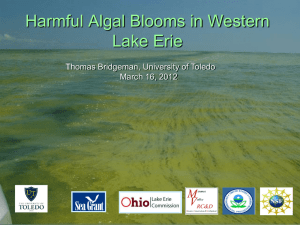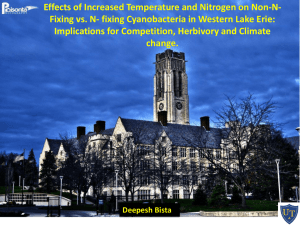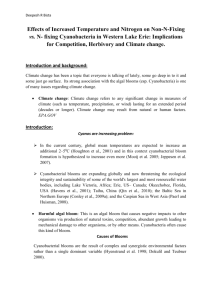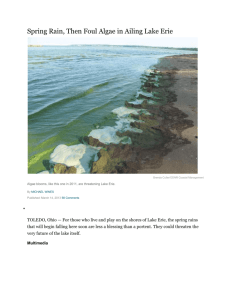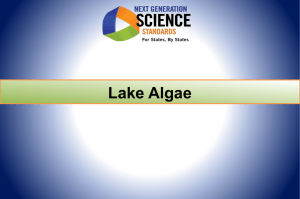LR-Chaffin-Erie-PA-8.. - Pennsylvania Sea Grant
advertisement
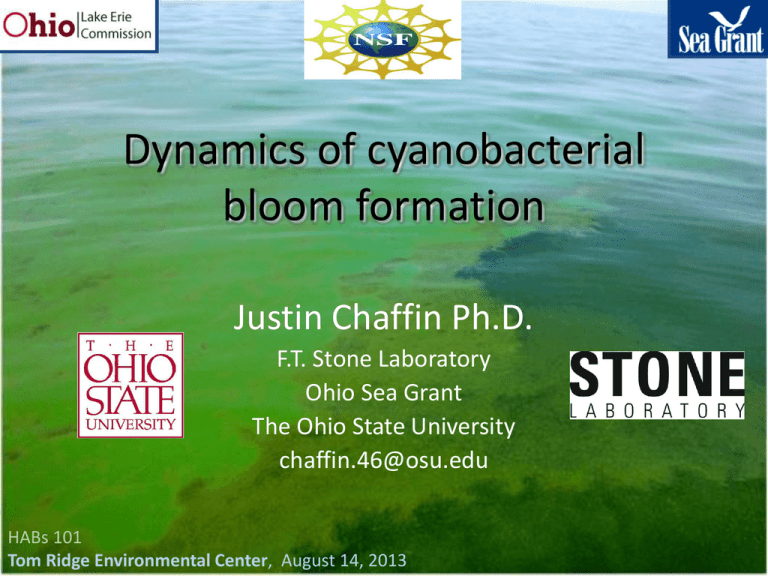
Dynamics of cyanobacterial bloom formation Justin Chaffin Ph.D. F.T. Stone Laboratory Ohio Sea Grant The Ohio State University chaffin.46@osu.edu HABs 101 Tom Ridge Environmental Center, August 14, 2013 There are hundreds of species of algae in Lake Erie Lake Erie food web Bottom organisms Major phytoplankton groups in Lake Erie • Diatoms • • • • Glass cell wall High lipid content Nutritional for zooplankton Spring blooms of diatoms in Lake Erie http://cfb.unh.edu/ Lake Erie diatom bloom during winter Twiss et al., 2012 J Great Lakes Res. Major phytoplankton groups in Lake Erie • Green Algae • Closely related to higher plants • Account for 50% of species in Lake Erie • Rarely bloom • Less lipid, but nutritious http://cfb.unh.edu/ Cladophora Cladophora epiphytes Cladophora chloroplast Cladophora chloroplast Major phytoplankton groups in Lake Erie • Cyanobacteria • • • • • • “Blue-green algae” Some contain gas vacuoles Some produce toxins Some fix nitrogen Low lipid, low nutrition Just a few are “Harmful” – Synechococcus ~ 50% of oxygen http://cfb.unh.edu/ Other algae of Lake Erie http://cfb.unh.edu/phycokey/phycokey.htm Lake Erie produces the most fish of all the Great Lakes because it has the most algae • Highest nutrient concentrations • Warmest water temperature Too much of the wrong kind of algae is harmful • “Bloom” is an excessive amount of algae • “Harmful algae bloom” is a bloom of potentially harmful algae. Photo Credit: Drs Jeff Reutter and Doug Kane What is a Harmful Algal Bloom? • Harmful = – Has the potential to produce toxins. – Harmful impacts on ecosystems • Algal = – Blue-green algae (cyanobacteria) – Red tide (dinoflagellates) geology.com • Bloom = – Biomass that far exceed normal Hungeree.com Are there non-harmful algal blooms? • Cladophora • Diatoms • These algae can reach high biomasses but do not produce toxins harmful to humans or animals – But can have other negative impacts Turtles.org Not an algal bloom: • • • • Duckweed Lily pads Submerged plants Lawn clippings Algal blooms are a global problem • Due to humans increasing nutrient loading Lake Erie, USA Lake Nieuwe Meer, Netherlands Lake Taihu, China Problems associated algal blooms • “Blooms” of cyanobacteria – Produce toxins – Low diversity of phytoplankton • • • • whoi.edu, W. Carmichael Taste and smell problems Low dissolved oxygen Property value decreases Negative economic impacts geolocation.ws High phosphorus concentrations are required for eutrophication + Carbon + Nitrogen Dense algae bloom + Carbon + Nitrogen No algae bloom Schindler 1974. Science Bloom requirements • Water temperatures > 15 °C – July, August, September in Lake Erie • High nutrient concentrations – Run off associated with rain storms – Phosphorus typically is the “limiting nutrient” – Nitrogen is important in cyanotoxin production Lake Erie cyanobacteria blooms MODIS Lake Erie 2011 Microcystis is the major blue-green algae in Lake Erie http://cfb.unh.edu/phycokey/phycokey.htm Microcystis http://cfb.unh.edu/phycokey/phycokey.htm Microcystis http://cfb.unh.edu/phycokey/phycokey.htm Anabaena common late summer http://cfb.unh.edu/phycokey/phycokey.htm Non-blooming Cyanobacteria in Lake Erie Merismopedia Chroococcus http://cfb.unh.edu/phycokey/phycokey.htm Lake Erie blooms have been typically confined to western Lake Erie: Microcystis landsat Lake Erie 2011 A) B) C) D) E) F) June 1 July 19 July 31 August 11 September 3 October 9 Michalak et al. 2013 PNAS Variation in Microcystis bloom intensity of Lake Erie Microcystis biovolume (mL/m2/year) 40000 35000 30000 25000 20000 15000 10000 5000 0 2002 2003 2004 2005 2006 2007 2008 2009 2010 2011 2012 Year Bridgeman et al., 2013. Journal of Great Lakes Research 2011 Record-breaking bloom explained Maumee River spring phosphorus load explains the size of the bloom Stumpf et al. 2012 PloS One Most P loading occurs during storms Michalak et al. 2013. Proc Nat Acad Sci Calm summer increased residence time of Maumee Bay • Spring storm water sat in Maumee Bay during summer and provide the perfect incubator for cyanobacteria. Michalak et al. 2013. Proc Nat Acad Sci Calm water favors Microcystis Calm Mixed • Microcystis wins in calm water and deeper water • Diatoms win in mixed water Clear Huisman et al. 2004 Turbid Photo credit: Roger Knight 2011 Record-breaking bloom explained • Many large spring storms • High P loading – Fertilized growth • Very calm early summer – Microcystis floated and thrived – Diatoms sank and died Other cyanobacteria blooms Sandusky Bay Planktothrix in Sandusky Bay http://cfb.unh.edu/phycokey/phycokey.htm Sandusky Bay – July 2012 Central basin Anabaena bloom Benthic Lyngbya in Maumee Bay Lyngbya http://cfb.unh.edu/phycokey/phycokey.htm Lyngbya at Stone Lab. August 20 2012 Lyngbya at Stone Lab. August 20 2012
